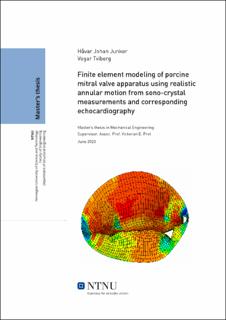| dc.contributor.advisor | Prot, Victorien | |
| dc.contributor.author | Junker, Håvar Johan | |
| dc.contributor.author | Tviberg, Vegar | |
| dc.date.accessioned | 2021-09-21T16:14:41Z | |
| dc.date.available | 2021-09-21T16:14:41Z | |
| dc.date.issued | 2020 | |
| dc.identifier | no.ntnu:inspera:56511028:20920291 | |
| dc.identifier.uri | https://hdl.handle.net/11250/2780038 | |
| dc.description.abstract | En grundig og nøyaktig forståelse av mitralklaffens dynamikk er nødvendig og etterspurt for å utvikle gode prognoser for langtidsvirkningene av mitralklaffdefekter. Numeriske beregningsmetoder, deriblant elementmetoden ("FEM"), kan brukes til å beregne de lokale deformasjonene i mitralklaffen. Dette har vist seg å være et verdifullt hjelpemiddel i klinisk sammenheng. Målet med denne studien var å utvikle en elementmetodemodell av mitralklaffen til et svinehjerte, basert på samsvarende piezoelektriske krystallmålinger og ultralydbilder tatt i et levende svinehjerte. Videre ble effekten av atriell kontraksjon på mitralklaffens globale dynamikk forsøkt kvantifisert ved hjelp av modifiserte randbetingelser. Den påfølgende evalueringen viste at modellen var sensitiv overfor nøyaktigheten til randbetingelsene. Videre funn indikerte at residualtøyninger i framtiden burde tas hensyn til for tilnærme den sanne tilstanden til klaffen bedre. De modifiserte randbetingelsene viste liten effekt på klaffens lukkemekanisme, og det konkluderes tilslutt med at denne typen randbevegelse i seg selv ikke er i stand til å hindre lukkingen av mitralklaffen. For å være i stand til å validere funnene i denne studien konkluderes det med at bedre eksperimentelle målinger må innhentes. | |
| dc.description.abstract | A fundamental understanding of the mitral valve (MV) dynamics is needed to predict the long term outcome of its related diseases. Numerical mechanical analysis, herein the finite element method (FEM), can be used to assess the local and regional deformations of the MV. This method has proven a valuable tool in diagnostics and clinical research. The aim of this study was to investigate the influence of annular motion during atrial contraction on the MV closure of a porcine heart by generating a hyperelastic FEM-model. Using corresponding in vivo sono-crystal and 3D echocardiographic measurements, the influence of annular motion was quantified by modifying the dynamic boundary conditions of the model. The subsequent mechanical assessment showed that the model was sensitive to the accuracy of the boundary conditions, and that an implementation of residual strains in the model in necessary to better align with the in vivo state of the MV. Additionally, the modification of annular motion had little effect on the MV closure mechanism. Ultimately, it is concluded that the modified annular motion is not solely capable of hindering MV closure. However, experimental data with higher resolution is necessary to validate the results. | |
| dc.language | | |
| dc.publisher | NTNU | |
| dc.title | Finite element modeling of porcine mitral valve apparatus using realistic annular motion from sono-crystal measurements and corresponding echocardiography | |
| dc.type | Master thesis | |
